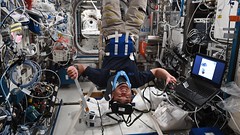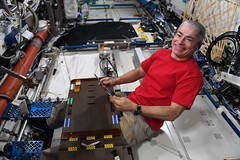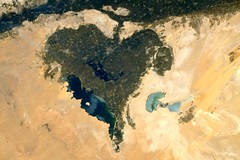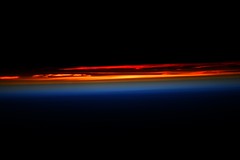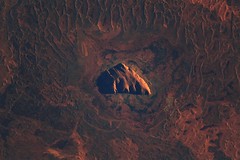Aki upside down for science
lundi 31 mai 2021 à 11:02Thomas Pesquet posted a photo:
This is Aki upside down (there is really no “up” and “down” in space, but lights and labels are always in the same orientation on the Space Station… so we have some reference :wink:). Aki was performing the Canadian Vection experiment in Columbus, that like the CNES/ESA Grasp experiment, is testing how our brains adapt to interpret the senses we have in weightlessness. This Canadian Space Agency experiment is focussing more on vection, that feeling we have all had when our brains think we are moving but we are not really, like when sitting in a train at the station and a train on the other platform starts moving. This false feeling of self-movement is well-known but you can imagine that testing it in space where everything is different is enticing to researchers.
Aki à l’envers pour la science – façon de parler : il n’y a bien sûr ni haut ni bas dans l’espace, mais sur la Station les éclairages et les inscriptions sont tous dans le même sens pour nous aider à nous y retrouver plus facilement, surtout quand il s’agit de chercher un outil/équipement.
Au moment du cliché, Aki commençait une session de l’expérience canadienne Vection dans le laboratoire Columbus. Elle suit un protocole similaire à sa cousine européenne Grasp, puisqu’il s’agit là aussi d’étudier comment notre cerveau interprète nos sens en impesanteur. Avec Vection, les scientifiques s’intéressent plus particulièrement à l’impression erronée qu’on peut avoir de bouger quand on est immobile, par exemple quand le train d’en face part alors que celui dans lequel on est assis est toujours à quai. C’est une illusion visuelle déjà bien connue sur Terre, mais il nous reste à découvrir dans quelle mesure elle s’applique en impesanteur. :thinking_face: Concrètement, Aki a dû estimer la distance et les dimensions d’un objet apparaissant dans son casque de réalité virtuelle, ainsi que son orientation à lui dans l’espace au même moment. Les chercheurs compareront les données recueillies avant, pendant et après la mission pour tirer leurs conclusions.
Credits: ESA/NASA–T. Pesquet
607A2800
